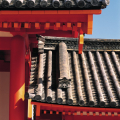IMPERIAL PALACE (GOSHO)
The Imperial Palace in Kyoto, Japan served as the official residence of the Emperor until 1868 at the beginning of the Meiji Era, when the power moved to Edo Castle (former seat of the shogun) which was renamed Kokyo, to make it the new residence of the Emperor. Since then the Kyōto-gosho is only a secondary residence of the imperial family. However, the coronation ceremonies of Emperors Taishō (Yoshihito) and Shōwa (Hirohito) were held at the palace. The present imperial palace was built in 1789, after the great fire of 1788. It burned down again in 1854 and was rebuilt once more. The present palace is located in the middle of a 84 ha park (Kyōto Gyoen). What strikes at first sight is its enclosure, called Tsuiji. The wall has been broken up into equal parts. A specific method of traditional construction in raw earth, adobe, has made it possible to preserve the original shades of color. There are a number of buildings that can still be seen and visited today:
Shishinden
. This 33 x 23 meter hall has a traditional architectural style with a gable roof. Each side of its main staircase overlooks a gray gravel courtyard, also used for official ceremonies, in which were planted trees that would become sacred and very famous: a cherry tree (sakura) on the east, and an orange tree (Tachibana) on the west.Hisahi
. The center of the hall is surrounded by a long and thin corridor which led to the throne room. Here the throne is visible, situated on an octagonal platform, five meters above the floor, and separated from the rest of the room by a curtain. The sliding door that hid the emperor from view was called a kenjō no shōji and was decorated with the images of 32 Chinese saints, one of the inspirational models for Heian period painting.Waitingrooms
. A series of three waiting rooms where people were separated and placed according to their social rank complete the picture. There is the "Cherry Tree Room" for the lower ranks and the "Tiger Room" for the higher ranks. And finally, the "Refreshing Hall", located west of the Shishinden, which was used for the emperor's personal affairs.outside
,
one can also see the Emperor's apartments, those of the Empress and concubines, and residences of high aristocrats and officials
.To the south of the palace is the Palace of the Retired Emperors, whose beautiful garden was designed by Enshū Kobori.
Did you know? This review was written by our professional authors.
Members' reviews on IMPERIAL PALACE (GOSHO)
The ratings and reviews below reflect the subjective opinions of members and not the opinion of The Little Witty.


